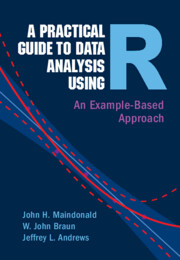Refine search
Actions for selected content:
1004 results in Computational statistics, machine learning and information science
Frontmatter
-
- Book:
- A Practical Guide to Data Analysis Using R
- Published online:
- 11 May 2024
- Print publication:
- 30 May 2024, pp i-iv
-
- Chapter
- Export citation
7 - Multilevel Models, and Repeated Measures
-
- Book:
- A Practical Guide to Data Analysis Using R
- Published online:
- 11 May 2024
- Print publication:
- 30 May 2024, pp 318-372
-
- Chapter
- Export citation
4 - Exploiting the Linear Model Framework
-
- Book:
- A Practical Guide to Data Analysis Using R
- Published online:
- 11 May 2024
- Print publication:
- 30 May 2024, pp 208-244
-
- Chapter
- Export citation
Index of R Functions
-
- Book:
- A Practical Guide to Data Analysis Using R
- Published online:
- 11 May 2024
- Print publication:
- 30 May 2024, pp 514-518
-
- Chapter
- Export citation
Dedication
-
- Book:
- A Practical Guide to Data Analysis Using R
- Published online:
- 11 May 2024
- Print publication:
- 30 May 2024, pp v-vi
-
- Chapter
- Export citation
Appendix A - The R System: a Brief Overview
-
- Book:
- A Practical Guide to Data Analysis Using R
- Published online:
- 11 May 2024
- Print publication:
- 30 May 2024, pp 469-494
-
- Chapter
- Export citation
6 - Time Series Models
-
- Book:
- A Practical Guide to Data Analysis Using R
- Published online:
- 11 May 2024
- Print publication:
- 30 May 2024, pp 292-317
-
- Chapter
- Export citation
Index of Terms
-
- Book:
- A Practical Guide to Data Analysis Using R
- Published online:
- 11 May 2024
- Print publication:
- 30 May 2024, pp 519-526
-
- Chapter
- Export citation
References
-
- Book:
- A Practical Guide to Data Analysis Using R
- Published online:
- 11 May 2024
- Print publication:
- 30 May 2024, pp 495-507
-
- Chapter
- Export citation
2 - Generalizing from Models
-
- Book:
- A Practical Guide to Data Analysis Using R
- Published online:
- 11 May 2024
- Print publication:
- 30 May 2024, pp 88-143
-
- Chapter
- Export citation
Preface
-
- Book:
- A Practical Guide to Data Analysis Using R
- Published online:
- 11 May 2024
- Print publication:
- 30 May 2024, pp xvii-xxiv
-
- Chapter
- Export citation
5 - Generalized Linear Models, and Survival Analysis
-
- Book:
- A Practical Guide to Data Analysis Using R
- Published online:
- 11 May 2024
- Print publication:
- 30 May 2024, pp 245-291
-
- Chapter
- Export citation
8 - Tree-Based Classification and Regression
-
- Book:
- A Practical Guide to Data Analysis Using R
- Published online:
- 11 May 2024
- Print publication:
- 30 May 2024, pp 373-399
-
- Chapter
- Export citation
References to R Packages
-
- Book:
- A Practical Guide to Data Analysis Using R
- Published online:
- 11 May 2024
- Print publication:
- 30 May 2024, pp 508-513
-
- Chapter
- Export citation

A Practical Guide to Data Analysis Using R
- An Example-Based Approach
-
- Published online:
- 11 May 2024
- Print publication:
- 30 May 2024
7 - Robust Supervised Learning
-
- Book:
- Algorithmic High-Dimensional Robust Statistics
- Published online:
- 24 August 2023
- Print publication:
- 07 September 2023, pp 204-228
-
- Chapter
- Export citation
6 - Robust Estimation via Higher Moments
-
- Book:
- Algorithmic High-Dimensional Robust Statistics
- Published online:
- 24 August 2023
- Print publication:
- 07 September 2023, pp 166-203
-
- Chapter
- Export citation
2 - Efficient High-Dimensional Robust Mean Estimation
-
- Book:
- Algorithmic High-Dimensional Robust Statistics
- Published online:
- 24 August 2023
- Print publication:
- 07 September 2023, pp 29-60
-
- Chapter
- Export citation
Preface
-
- Book:
- Algorithmic High-Dimensional Robust Statistics
- Published online:
- 24 August 2023
- Print publication:
- 07 September 2023, pp xi-xiv
-
- Chapter
- Export citation
Notation
-
- Book:
- Algorithmic High-Dimensional Robust Statistics
- Published online:
- 24 August 2023
- Print publication:
- 07 September 2023, pp xv-xvi
-
- Chapter
- Export citation
